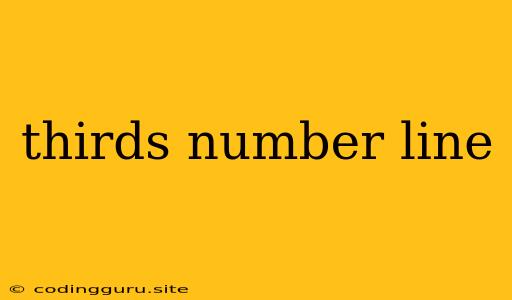Understanding the Number Line in Thirds
The number line is a fundamental tool in mathematics. It visually represents numbers in a linear fashion, helping us understand their order, relationships, and operations. But what happens when we divide the number line into thirds? This seemingly simple action opens up a world of possibilities and applications.
Why Thirds?
Dividing the number line into thirds allows us to represent numbers in a more granular way. Instead of just whole numbers, we can now express fractions and decimals with greater precision. Think of it like this: imagine a cake. If we cut it in half, we have two equal pieces. If we cut it into thirds, we have three equal pieces. Each piece represents a third of the whole.
Representing Thirds on the Number Line
To represent thirds on a number line, we first need to mark the key points:
- 0: This is the starting point of our number line.
- 1: This is the whole number representing one unit.
- 2: This is the whole number representing two units.
Now, to divide the space between each whole number into thirds, we simply divide the distance between them into three equal parts. This means that we have points representing one-third (1/3), two-thirds (2/3), and so on.
Example:
Let's look at the space between 0 and 1. We can mark 1/3, 2/3, and 3/3 (which is equal to 1). This gives us a clear visual representation of how these fractions relate to the whole number 1.
Applications of Thirds on the Number Line
Understanding how to represent thirds on the number line has several important applications:
- Fractions and Decimals: It helps visualize how fractions like 1/3, 2/3, and 4/3 relate to whole numbers and decimals like 0.333, 0.666, and 1.333, respectively.
- Measurement: This is particularly useful in measurement systems like the imperial system, where quantities are often expressed in fractions, such as 1/3 cup or 2/3 inch.
- Arithmetic: It allows for easier understanding of adding, subtracting, multiplying, and dividing fractions, as we can visually see the relationships between the numbers.
Tips for Working with Thirds on the Number Line
- Start with the basics: Practice marking 1/3, 2/3, and 3/3 (which equals 1) between 0 and 1.
- Visualize the whole: Remember that each third represents a part of the whole unit (1).
- Connect to decimals: Practice converting fractions to decimals and vice versa. This will help solidify your understanding of how thirds relate to other representations.
Conclusion
Dividing the number line into thirds is a simple but powerful concept. It provides a visual representation of fractions, decimals, and their relationship to whole numbers. This understanding is crucial for a deeper understanding of mathematics, particularly when working with measurement, arithmetic, and other applications.
By mastering the concept of thirds on the number line, you lay the foundation for a more robust understanding of mathematics and its applications in everyday life.
